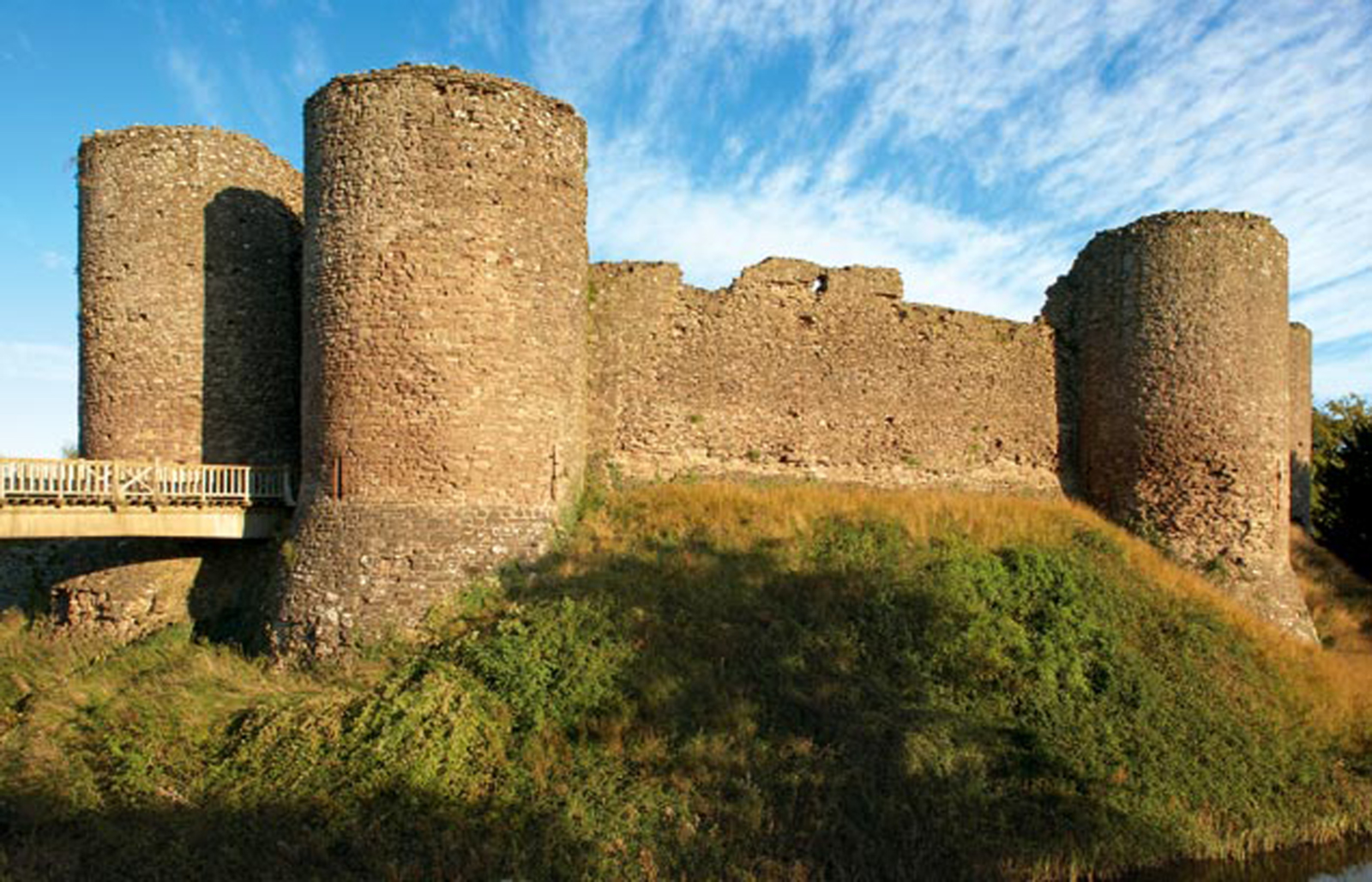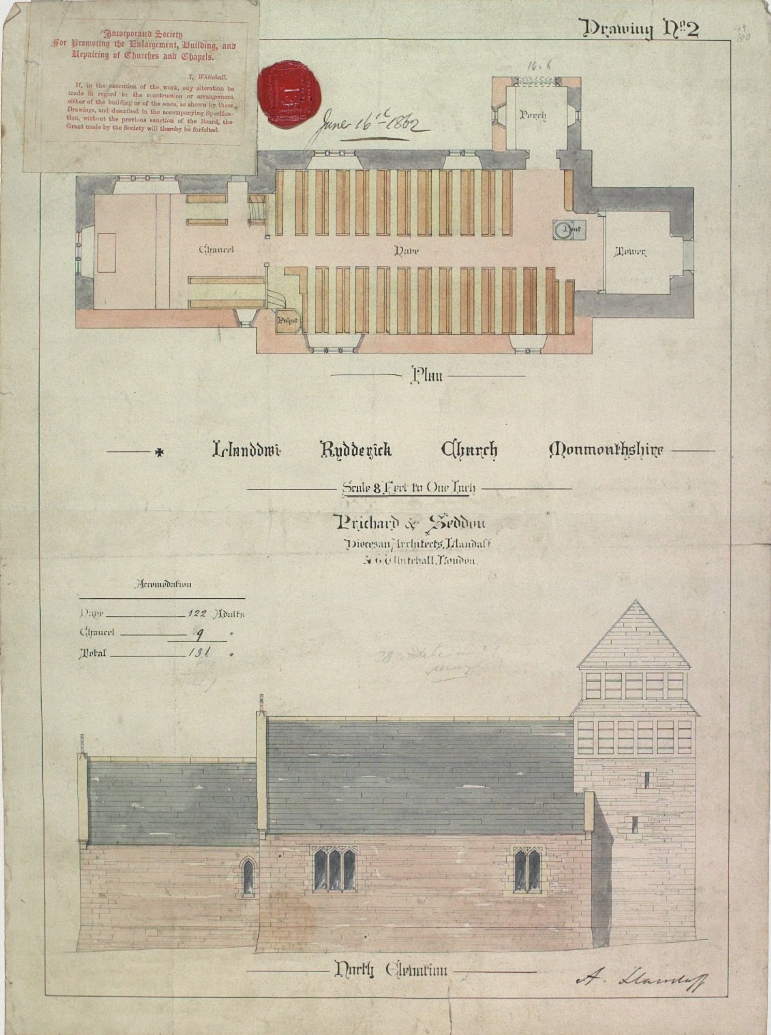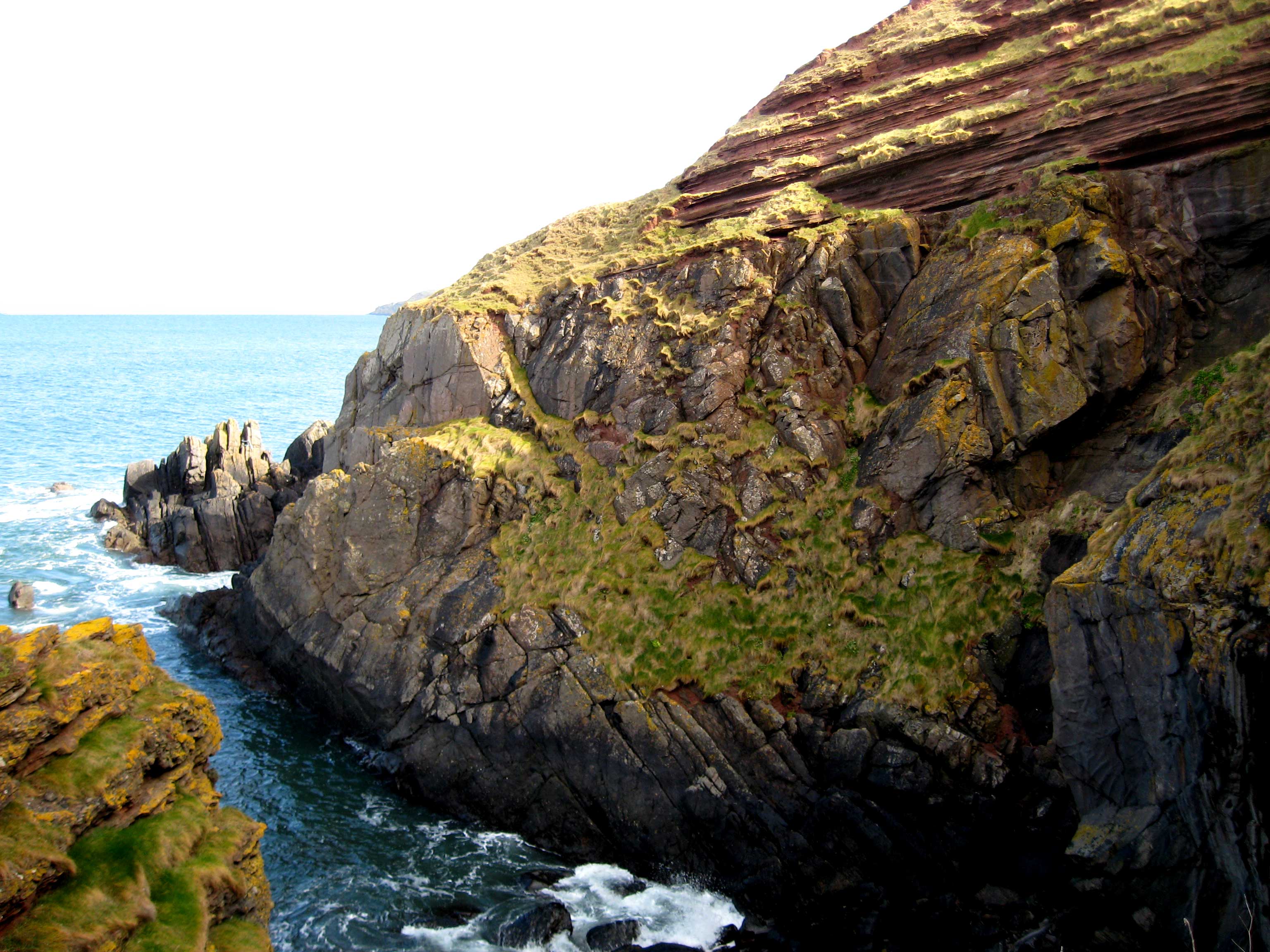|
Church Of St Teilo, Llantilio Crossenny
The Church of St Teilo is the parish church of Llantilio Crossenny, Monmouthshire, Wales. "An unusually grand cruciform church", with an Early English tower crossed by a Decorated chancel, it was designated a Grade I listed building on 19 November 1953 The church is dedicated to Saint Teilo. History and architecture Llantilio Crossenny was a manor of the Bishops of Llandaff in the Middle Ages, and the site of their manor house can still be seen at Hen Gwrt. Their episcopal presence and the proximity of White Castle account for the "exceptional scale" of the church. It is of Old Red Sandstone with a "landmark" shingled spire. The tower and the nave are of the thirteenth century whilst the chancel was rebuilt in the fourteenth. The spire was added in the early eighteenth century and the whole was restored by John Prichard and John Pollard Seddon in 1856–7. The interior is described as "outstanding" by the Royal Commission on the Ancient and Historical Monuments of Wales. ... [...More Info...] [...Related Items...] OR: [Wikipedia] [Google] [Baidu] |
Church In Wales
The Church in Wales ( cy, Yr Eglwys yng Nghymru) is an Anglicanism, Anglican church in Wales, composed of six dioceses. The Archbishop of Wales does not have a fixed archiepiscopal see, but serves concurrently as one of the six diocesan bishops. The position is currently held by Andy John, Bishop of Bangor, since 2021. Unlike the Church of England, the Church in Wales is not an established church. Disestablishmentarianism, Disestablishment took place in 1920 under the Welsh Church Act 1914. As a province of the Anglican Communion, the Church in Wales recognises the Archbishop of Canterbury as a focus of unity but without any formal authority. A cleric of the Church in Wales can be appointed to posts in the Church of England, including the See of Canterbury; a former Archbishop of Canterbury, Rowan Williams, was from Wales and served as Archbishop of Wales before his appointment to Canterbury. Official name The Church in Wales ( cy, Yr Eglwys yng Nghymru) adopted its name by a ... [...More Info...] [...Related Items...] OR: [Wikipedia] [Google] [Baidu] |
White Castle, Monmouthshire
White Castle ( cy, Castell Gwyn), also known historically as Llantilio Castle, is a ruined castle near the village of Llantilio Crossenny in Monmouthshire, Wales. The fortification was established by the Normans in the wake of the invasion of England in 1066, to protect the route from Wales to Hereford. Possibly commissioned by William fitz Osbern, the Earl of Hereford, it comprised three large earthworks with timber defences. In 1135, a major Welsh revolt took place and in response King Stephen brought together White Castle and its sister fortifications of Grosmont and Skenfrith to form a lordship known as the "Three Castles", which continued to play a role in defending the region from Welsh attack for several centuries. King John gave the castle to a powerful royal official, Hubert de Burgh, in 1201. Over the next few decades, it passed back and forth between several owners, as Hubert, the rival de Braose family, and the Crown took control of the property. During this perio ... [...More Info...] [...Related Items...] OR: [Wikipedia] [Google] [Baidu] |
Grade I Listed Churches In Monmouthshire
Grade most commonly refers to: * Grade (education), a measurement of a student's performance * Grade, the number of the year a student has reached in a given educational stage * Grade (slope), the steepness of a slope Grade or grading may also refer to: Music * Grade (music), a formally assessed level of profiency in a musical instrument * Grade (band), punk rock band * Grades (producer), British electronic dance music producer and DJ Science and technology Biology and medicine * Grading (tumors), a measure of the aggressiveness of a tumor in medicine * The Grading of Recommendations Assessment, Development and Evaluation (GRADE) approach * Evolutionary grade, a paraphyletic group of organisms Geology * Graded bedding, a description of the variation in grain size through a bed in a sedimentary rock * Metamorphic grade, an indicatation of the degree of metamorphism of rocks * Ore grade, a measure that describes the concentration of a valuable natural material in the surroun ... [...More Info...] [...Related Items...] OR: [Wikipedia] [Google] [Baidu] |
Charles Eamer Kempe
Charles Eamer Kempe (29 June 1837 – 29 April 1907) was a British Victorian era designer and manufacturer of stained glass. His studios produced over 4,000 windows and also designs for altars and altar frontals, furniture and furnishings, lichgates and memorials that helped to define a later nineteenth-century Anglican style. The list of English cathedrals containing examples of his work includes: Chester, Gloucester, Hereford, Lichfield, Wells, Winchester and York. Kempe's networks of patrons and influence stretched from the Royal Family and the Church of England hierarchy to the literary and artistic beau monde. Early life Charles Kempe was born at Ovingdean Hall, near Brighton, East Sussex in 1837. He was the youngest son of Nathaniel Kemp (1759–1843), a cousin of Thomas Read Kemp, a politician and property developer responsible for the Kemptown area of BrightonKempe added the 'e' to his name in adult life and the maternal grandson of Sir John Eamer, who served as Lord ... [...More Info...] [...Related Items...] OR: [Wikipedia] [Google] [Baidu] |
Stained Glass
Stained glass is coloured glass as a material or works created from it. Throughout its thousand-year history, the term has been applied almost exclusively to the windows of churches and other significant religious buildings. Although traditionally made in flat panels and used as windows, the creations of modern stained glass artists also include three-dimensional structures and sculpture. Modern vernacular usage has often extended the term "stained glass" to include domestic lead light and ''objets d'art'' created from foil glasswork exemplified in the famous lamps of Louis Comfort Tiffany. As a material ''stained glass'' is glass that has been coloured by adding metallic salts during its manufacture, and usually then further decorating it in various ways. The coloured glass is crafted into ''stained glass windows'' in which small pieces of glass are arranged to form patterns or pictures, held together (traditionally) by strips of lead and supported by a rigid frame. Painte ... [...More Info...] [...Related Items...] OR: [Wikipedia] [Google] [Baidu] |
Edward II
Edward II (25 April 1284 – 21 September 1327), also called Edward of Caernarfon, was King of England and Lord of Ireland from 1307 until he was deposed in January 1327. The fourth son of Edward I, Edward became the heir apparent to the throne following the death of his elder brother Alphonso. Beginning in 1300, Edward accompanied his father on invasions of Scotland. In 1306, he was knighted in a grand ceremony at Westminster Abbey. Following his father's death, Edward succeeded to the throne in 1307. He married Isabella, the daughter of the powerful King Philip IV of France, in 1308, as part of a long-running effort to resolve tensions between the English and French crowns. Edward had a close and controversial relationship with Piers Gaveston, who had joined his household in 1300. The precise nature of their relationship is uncertain; they may have been friends, lovers, or sworn brothers. Edward's relationship with Gaveston inspired Christopher Marlowe's 159 ... [...More Info...] [...Related Items...] OR: [Wikipedia] [Google] [Baidu] |
Corbels
In architecture, a corbel is a structural piece of stone, wood or metal jutting from a wall to carry a superincumbent weight, a type of bracket. A corbel is a solid piece of material in the wall, whereas a console is a piece applied to the structure. A piece of timber projecting in the same way was called a "tassel" or a "bragger" in England. The technique of corbelling, where rows of corbels deeply keyed inside a wall support a projecting wall or parapet, has been used since Neolithic (New Stone Age) times. It is common in medieval architecture and in the Scottish baronial style as well as in the vocabulary of classical architecture, such as the modillions of a Corinthian cornice. The corbel arch and corbel vault use the technique systematically to make openings in walls and to form ceilings. These are found in the early architecture of most cultures, from Eurasia to Pre-Columbian architecture. A console is more specifically an "S"-shaped scroll bracket in the classical t ... [...More Info...] [...Related Items...] OR: [Wikipedia] [Google] [Baidu] |
Royal Commission On The Ancient And Historical Monuments Of Wales
The Royal Commission on the Ancient and Historical Monuments of Wales (RCAHMW; cy, Comisiwn Brenhinol Henebion Cymru; ), established in 1908, is a Welsh Government sponsored body concerned with some aspects of the archaeological, architectural and historic environment of Wales. It is based in Aberystwyth. The RCAHMW maintains and curates the National Monuments Record of Wales (NMRW), an archive with an online platform called Coflein. Professor Nancy Edwards is Chair of the Commissioners. Mission statement The Royal Commission has a national role in the management of the archaeological, built and maritime heritage of Wales, as an originator, curator and supplier of information for individual, corporate and governmental decision-makers, researchers and the general public. To this end it: * Surveys, interprets and records the man-made environment of Wales * Compiles, maintains and curates the National Monuments Record of Wales * Promotes an understanding of this information by ... [...More Info...] [...Related Items...] OR: [Wikipedia] [Google] [Baidu] |
John Pollard Seddon
John Pollard Seddon FRIBA (19 September 1827 – 1 February 1906) was a British architect, working largely on churches. His father was a cabinetmaker, and his brother Thomas Seddon (1821–1856) a landscape painter. Born in London, he was educated at Bedford School. He was later a pupil of Thomas Leverton Donaldson, though Donaldson was a classical architect and Seddon preferred the Gothic Revivalism of John Ruskin. Between 1852 and 1863, Seddon formed a partnership with John Prichard. Many of their major commissions were church restoration works, most famously for Llandaff Cathedral. In 1871 he submitted a design in a competition for Holloway Sanatorium. C. F. A. Voysey was articled as a pupil of Seddon in 1873. From 1884 to 1904 he was in partnership with John Coates Carter. In 1904 he was Diocesan Architect for London and designed a gigantic Imperial Monumental Halls, with a tall tower, to be added to Westminster Abbey; it was intended to restore the dominance of the ab ... [...More Info...] [...Related Items...] OR: [Wikipedia] [Google] [Baidu] |
John Prichard
John Prichard (6 May 1817 – 13 October 1886) was a Welsh architect in the neo-Gothic style. As diocesan architect of Llandaff, he was involved in the building or restoration of many churches in south Wales. Personal history John Prichard was born in Llangan, near Cowbridge, Wales on 6 May 1817, the twelfth son of the rector Richard Prichard, who served as vicar-choral of Llandaff for 35 years. He was descended from the Prichard family of Collenna. John Prichard trained as an architect under Thomas Larkins Walker, and as a result was deeply influenced by the ideas of Augustus Pugin; much of his work was in a neo-Gothic style. He established a practice in Llandaff, Cardiff, becoming 'Resident Diocesan Architect' in December 1844. Between 1852 and 1863 he was in partnership with John Pollard Seddon. Many of his major commissions were restoration works, most famously for Llandaff Cathedral (1843–69); Prichard and Seddon worked on the cathedral from the 1840s until ... [...More Info...] [...Related Items...] OR: [Wikipedia] [Google] [Baidu] |
Roof Shingle
Roof shingles are a roof covering consisting of individual overlapping elements. These elements are typically flat, rectangular shapes laid in courses from the bottom edge of the roof up, with each successive course overlapping the joints below. Shingles are held by the roof rafters and are made of various materials such as wood, slate, flagstone, metal, plastic, and composite materials such as fibre cement and asphalt shingles. Ceramic roof tiles, which still dominate in Europe and some parts of Asia, are still usually called tiles. Roof shingles may deteriorate faster and need to repel more water than wall shingles. They are a very common roofing material in the United States. Etymology and nomenclature Shingle is a corruption of German meaning a roofing slate."Shingle" def. 1. Whitney, Willi ... [...More Info...] [...Related Items...] OR: [Wikipedia] [Google] [Baidu] |
Old Red Sandstone
The Old Red Sandstone is an assemblage of rocks in the North Atlantic region largely of Devonian age. It extends in the east across Great Britain, Ireland and Norway, and in the west along the northeastern seaboard of North America. It also extends northwards into Greenland and Svalbard. These areas were a part of the ancient continent of Euramerica, Euramerica/Laurussia. In Britain it is a lithostratigraphy, lithostratigraphic unit (a sequence of rock strata) to which Stratigraphy, stratigraphers accord Geological unit#Lithostratigraphic units, supergroup status and which is of considerable importance to early paleontology. For convenience the short version of the term, ORS is often used in literature on the subject. The term was coined to distinguish the sequence from the younger New Red Sandstone which also occurs widely throughout Britain. Sedimentology The Old Red Sandstone describes a suite of sedimentary rocks deposited in a variety of environments during the Devonian ... [...More Info...] [...Related Items...] OR: [Wikipedia] [Google] [Baidu] |






